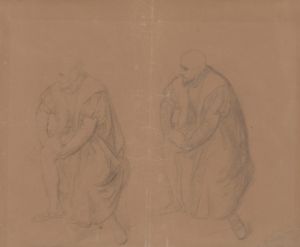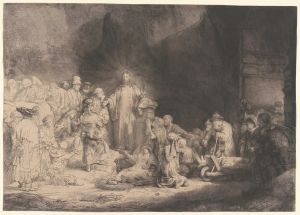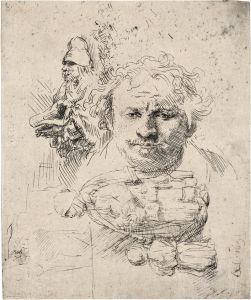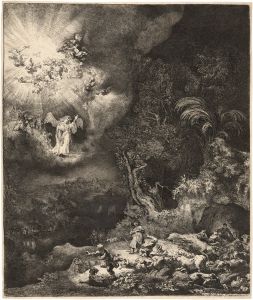
Nathan Admonishing David
A hand-painted replica of Rembrandt van Rijn’s masterpiece Nathan Admonishing David, meticulously crafted by professional artists to capture the true essence of the original. Each piece is created with museum-quality canvas and rare mineral pigments, carefully painted by experienced artists with delicate brushstrokes and rich, layered colors to perfectly recreate the texture of the original artwork. Unlike machine-printed reproductions, this hand-painted version brings the painting to life, infused with the artist’s emotions and skill in every stroke. Whether for personal collection or home decoration, it instantly elevates the artistic atmosphere of any space.
"Nathan Admonishing David" is a painting attributed to the renowned Dutch artist Rembrandt van Rijn, created during the Dutch Golden Age. This period, spanning the 17th century, was marked by great wealth and cultural achievement in the Netherlands, with Rembrandt being one of its most celebrated figures. Known for his masterful use of light and shadow, as well as his profound ability to capture human emotion, Rembrandt's works often explore biblical and historical themes.
The painting depicts a scene from the Old Testament, specifically from the Second Book of Samuel, Chapter 12. This biblical narrative involves the prophet Nathan confronting King David after David's adultery with Bathsheba and the arranged death of her husband, Uriah the Hittite. In the story, Nathan uses a parable to reveal David's wrongdoing, leading to the king's repentance. This moment of moral reckoning and divine judgment is a powerful subject, reflecting themes of sin, guilt, and redemption.
In "Nathan Admonishing David," Rembrandt captures the dramatic tension of the confrontation. The composition likely emphasizes the emotional intensity of the moment, with Nathan pointing an accusatory finger at David, who is often depicted in a state of shock or remorse. Rembrandt's skillful use of chiaroscuro—the contrast between light and dark—would have been employed to highlight the figures and their expressions, drawing the viewer's attention to the psychological drama unfolding.
Rembrandt's ability to convey complex human emotions through facial expressions and body language is evident in this work. The painting would typically feature a rich palette, with deep, warm colors that are characteristic of Rembrandt's style. The textures of the clothing and the play of light across the figures would add to the realism and immediacy of the scene.
While the exact date of the painting's creation is not definitively known, it is generally placed within the mature period of Rembrandt's career, when he was deeply engaged with biblical subjects. During this time, Rembrandt's work was marked by a profound exploration of human character and moral themes, making "Nathan Admonishing David" a fitting example of his artistic and thematic concerns.
The painting is part of a broader tradition of biblical art in the 17th century, where artists sought to depict religious stories with emotional depth and moral clarity. Rembrandt's interpretation of the Nathan and David story would have resonated with contemporary audiences familiar with the biblical text and its moral implications.
As with many of Rembrandt's works, "Nathan Admonishing David" reflects his interest in the human condition and the complexities of moral choice. The painting serves as a visual meditation on the themes of sin, repentance, and forgiveness, inviting viewers to reflect on their own moral and ethical beliefs.
Overall, "Nathan Admonishing David" exemplifies Rembrandt's mastery of narrative painting, his ability to convey deep emotional truths, and his enduring interest in the moral and spiritual dimensions of human life.


















